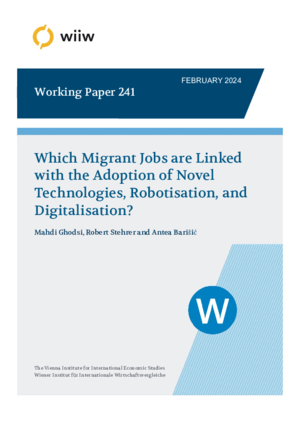Which Migrant Jobs are Linked with the Adoption of Novel Technologies, Robotisation, and Digitalisation?
Antea Barišić, Mahdi Ghodsi and Robert Stehrer
wiiw Working Paper No. 241, February 2024
63 pages including 16 Tables and 10 Figures
In recent decades, the development of novel technologies has intensified due to globalisation, prompting countries to enhance competitiveness through innovation. These technologies have significantly improved global welfare, particularly in sectors like healthcare, where they have facilitated tasks and boosted productivity, for example playing a crucial role in combating the COVID-19 pandemic. However, certain technologies, such as robots, can negatively impact employment by replacing workers and tasks. Additionally, the emergence of artificial intelligence as digital assets not only replaces specific tasks but also introduces complexities that may displace employees who are unable to adapt. While the existing literature extensively explores the heterogeneous effects of these technologies on labour markets, studies of their impact on migrant workers remain scarce. This paper presents pioneering evidence on the effects of various novel technologies on migrant employment in the European Union. The analysis covers 18 EU member states from 2005 to 2019 focusing on the impact of novel innovations, robot adoption, three types of digital assets, and total factor productivity, on migrant employment. The key findings reveal that innovations measured by the number of granted patents increase both the number and proportion of migrant workers relative to the overall workforce. While robots do replace jobs, their impact on native workers surpasses that of migrant workers, resulting in a higher share of migrant workers following robot adoption. Total factor productivity positively influences migrant workers, while the effects of digital assets are heterogeneous. Moreover, the impacts of these technologies on migrant workers vary significantly across different occupation types and educational levels.
Keywords: Robot adoption, digitalisation, novel innovation, migrant workers
JEL classification: O33, F22, D24
Countries covered: European Union
Research Areas: Labour, Migration and Income Distribution
